When selecting a mixing technology, wastewater treatment plants (WWTPs) and their consultant engineers must consider numerous factors, balancing specific treatment demands with plant priorities and ultimately choosing the technology that best suits their needs and specifications. Compressed gas mixing (CGM) is often the best solution, allowing designers to circumvent many challenges that alternative technologies either create or cannot overcome. Widely accepted, CGM has gained popularity over the past decade as its consistent advantages have been realized more broadly throughout the market.
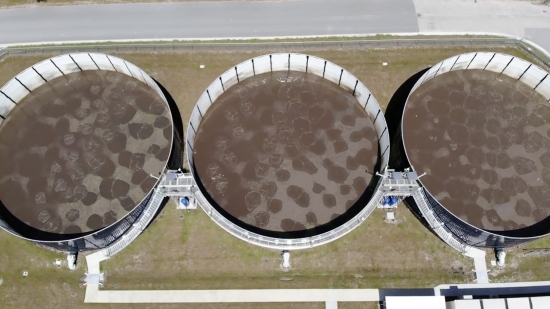
Influent flow equalization tanks at NRWRF in Manatee County, Florida.
Developed by EnviroMix, BioMix™ Compressed Gas Mixing provides uniform mixing of tank contents by firing programmed, short-duration, high-intensity bursts of compressed air through patented, engineered nozzles located near the tank floor. Mixing parameters — including pressure, sequence, duration, and frequency — may be adjusted, either through operator input or automatic process feedback, to optimize power utilization and deliver ideally mixed conditions.
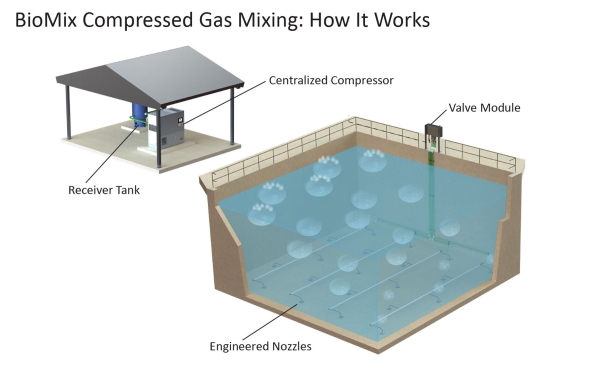
BioMix starts with a centralized compressor system that can be used for multiple applications, regardless of treatment process, liquid depth, or solids concentration. The compressor, which uses ambient air, modulates output to maintain system pressure while conserving energy when demand is low. Charged by the compressor, the receiver tank supplies compressed air to the valve module. The valve module controls the mixing intensity and releases the bottled-up air in high-pressure, high-velocity timed bursts through groups of nozzles across the floor of the tank. Large volumes of gas generate an upwelling motion and create circulatory currents, suspending solids and maintaining a completely mixed environment.
BioMix empowers design engineers and WWTPs to eliminate the following formidable challenges, delivering a wide range of benefits along the way.
Challenge 1: Wasted Energy
BioMix systems provide significant power savings compared to mechanical mixers by uniformly distributing mixing energy across the basin floor rather than directing it outward from a localized point in the tank. Multiple studies have documented a 60% or greater reduction in power usage versus mechanical mixers and even more versus diffused air mixing.
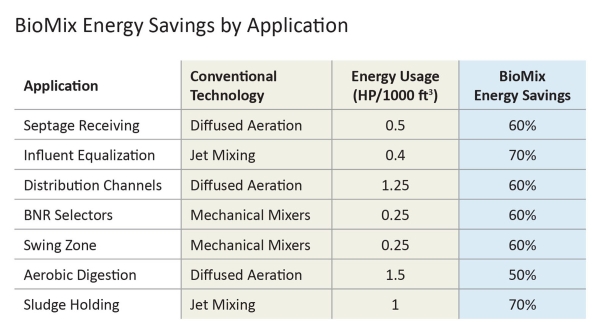
Case Study: Manatee County, Florida
In 2017, Manatee County upgraded the North Regional Water Reclamation Facility (NRWRF). Treatment was improved through the construction of three 1-million-gallon influent flow equalization tanks utilizing a BioMix system. Use of BioMix in lieu of conventional diffused aeration resulted in energy cost savings of over $150,000 annually.
The NRWRF system utilizes one duty and one standby 30 HP compressor to provide the mixing energy for all three equalization tanks. A traditional diffused aeration mixing system would require ten times the horsepower to provide equivalent mixing. Optimal mixed conditions for each tank are automatically adjusted to accommodate variable depth operation, ranging from a few feet of liquid depth to a maximum of 23 feet. The BioMix system reduced the facility’s O&M costs by 90% versus conventional diffused air mixing, saving Manatee County millions of dollars over the life the system.
Challenge 2: High Maintenance Demands
All in-tank components of a BioMix system are maintenance free, non-clogging, and self-cleaning. While conventional solutions require high maintenance impellers, motive pumps, diffusers, blowers, and more, the centralized compressor system creates a single maintenance touchpoint in a controlled environment. Electrical requirements are limited to the power needed to operate the air compressor and the valve modules.
Based on his nearly 30 years of industry experience, Superintendent Blaine Shipley of Price River Water Improvement District in Wellington, Utah, stated about BioMix, “I like the fact that there are no mechanical or electrical parts underwater. That's part of the reason I wanted to go this [CGM] route versus some other kind of mechanical mixing. And I like the fact that it's pretty much all stainless steel. So, there's not much opportunity for corrosion.” Shipley added, “The system is surprisingly even more simple and easy to take care of than I expected.”
“The maintenance is super minimal. There is nothing we have to do to this tank. It works perfectly,” said Greg Hill, Operations Manager at Mount Pleasant (SC) Waterworks, of his BioMix system.
Challenge 3: Integration with Aeration
Unlike mechanical mixers, bottom-up CGM easily integrates with aeration equipment for swing zone, low oxygen demand, and mixing limited applications. The technology can operate concurrently with or independently from aeration for optimized process conditions. Decoupling oxygen demand from mixing requirements provides the operational flexibility to reduce the diffused aeration system airflow rate to meet the air required for plant loading.
BioMix nozzles interlaced with diffused aeration.
BioMix nozzles can be interlaced with diffused aeration grids, allowing simultaneous operation at a wide range of airflow rates. This results in:
- Promotion of anoxic and anaerobic conditions to enable biological nutrient removal (BNR)
- Simultaneous nitrification and denitrification
- Conditions that promote a healthy biomass with good settling characteristics
- Stable dissolved oxygen (DO) profile throughout the aeration tank
- Significant energy savings
BioMix uniformly mixes tank contents at 85% less energy than diffused air mixing. Though it may look like coarse bubble aeration to the untrained observer, BioMix produces a much larger, intermittent bubble with 95% less air volume so it doesn’t transfer oxygen.
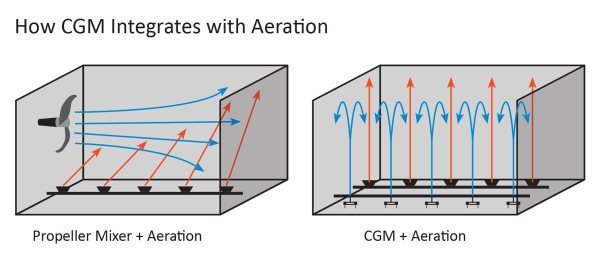
Challenge 4: Dead Zones and Minimum Operating Depths
BioMix’s patented nozzles and headers are compatible with any tank geometry or configuration. Headers are designed to conform to the slope of the tank floor, eliminating “dead spots.” The system can also mix through a range of operating depths with no low-level limitations.
Case Study: Emporia, Kansas
The City of Emporia upgraded its wastewater treatment plant in 2019 with a primary goal of upgrading and expanding the plant’s conventional activated sludge process to an integrated fixed film activated sludge (IFAS) process with aerobic sludge digestion. The design team selected EnviroMix technologies for the BNR selectors and the aerobic sludge digestors.
The upgraded aerobic digestion system utilizes a pre-existing 27’ deep anaerobic digester that was converted to an aerobic digester and a new 18.5’ deep aerobic digester that is about 50% greater in capacity. Both digesters have deep conical hopper bottoms, making it virtually impossible to completely mix the tanks with just a diffused aeration system. The BioMix system was installed below the aeration grid following the slope of the floor to ensure mixing all the way to the bottom of the cone, thereby eliminating the large dead volume that would result in sludge deposition and digester upsets due to septic conditions.
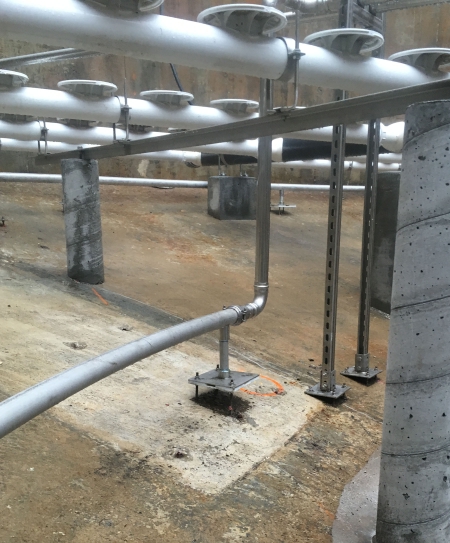
BioMix nozzles alleviate dead zones in the aerobic digester in Emporia, Kansas.
When selecting the mixing technology that best suits their specific needs, WWTPs and consultant engineers must consider all the options that are available to them. CGM offers a powerful energy-efficient, low-maintenance solution that supports process optimization and highly scalable and flexible operations.
About the Authors
Sarah Elger, P.E. is the director of strategy and marketing at EnviroMix Inc. She has been in the water and wastewater industry for more than 15 years and specializes in biological wastewater treatment and process controls. Sarah received her B.S. in engineering mechanics from University of Wisconsin; received her M.S. in environmental engineering from Milwaukee School of Engineering; and is a registered professional engineer in the State of Wisconsin.
John Koch, P.E. is currently the vice president of technology at EnviroMix, Inc. He received his B.S. in civil engineering from Marquette University. John has more than 30 years of experience in the wastewater treatment industry, specializing in biological wastewater treatment systems including sequencing batch reactors, membrane bioreactors, membrane aerated biofilm reactors, oxidation ditches, and conventional activated sludge systems. John is an active member of Water Environment Federation and a registered professional engineer in the State of Illinois.
About EnviroMix
With offices in Charleston, SC, and Grafton, WI, EnviroMix designs and manufactures treatment technologies which protect the environment and reduce energy consumption in the water and wastewater industry. Utilizing patented and proprietary technology, we provide mixing and process control solutions to enhance plant performance for a wide variety of applications in the treatment process. Visit enviro-mix.com for more information.
To read similar articles on Industrial and Municipal Wastewater please visit
https://www.blowervacuumbestpractices.com/industries/wastewater.
Visit our Webinar Archives to listen to expert presentations on Aeration Blower Systems at https://www.blowervacuumbestpractices.com/magazine/webinars.




